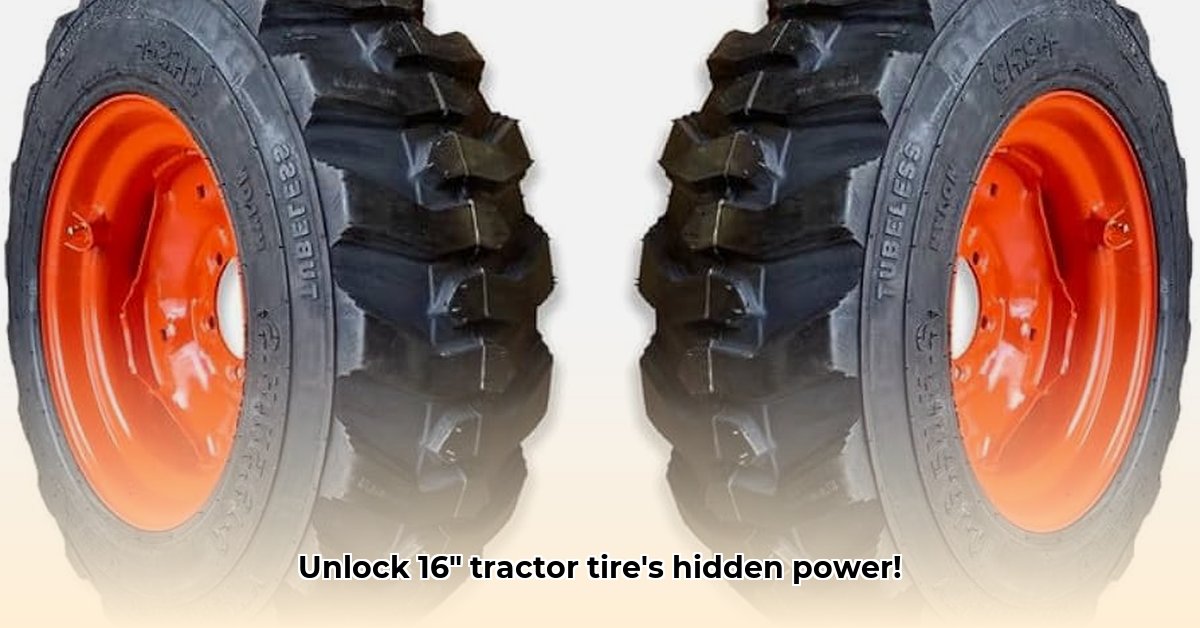
Understanding 16-Inch Tractor Tires and Sustainable Agriculture
Proper tire selection is paramount for sustainable agricultural practices. 16-inch tractor tires, while seemingly small, significantly impact fuel efficiency, soil compaction, and overall operational efficiency. This guide provides actionable steps for selecting, maintaining, and utilizing these tires to optimize your farm's sustainability. Don't underestimate the power of the right tire; it's a cornerstone of environmentally responsible farming. How can you ensure your tire choices align with your sustainability goals? For more information on agricultural tires, check out this helpful resource: tire selection guide.
Understanding Tire Specifications
Several key parameters define 16-inch tractor tires. Understanding these is crucial for making informed choices:
- Size: This is the tire's overall dimensions (e.g., 6.00-16).
- Load Index: Indicates the maximum weight the tire can carry (higher is better).
- Speed Rating: Specifies the tire's maximum safe speed.
- Ply Rating: Refers to the number of layers in the tire (more plies generally mean greater durability).
- Tread Pattern: Different patterns (ribbed, lugged, intermediate) offer varying levels of traction and soil interaction. For example, a lugged tread provides superior traction in mud, while a ribbed tread is better suited for hard surfaces.
Selecting the Right 16-Inch Tractor Tire
Tire selection depends on several factors:
Soil Type: Clay soils need aggressive treads for traction; sandy soils might benefit from wider tires to avoid sinking. Loamy soils represent a middle ground.
Terrain: Hilly terrain necessitates tires with superior grip to prevent slippage, often requiring deeper lug patterns for enhanced traction.
Workload: Heavier loads demand tires with higher load indices, ensuring safe operation and preventing overloading.
Environmental Considerations: Low rolling resistance tires minimize fuel consumption and reduce your farm's carbon footprint while lower tire pressures reduce soil compaction. Isn't minimizing your environmental impact a top priority?
Tire Maintenance and Care: A Step-by-Step Guide
Regular maintenance extends tire life and optimizes performance:
Inflation: Check tire pressure weekly using a reliable gauge. Inflate to the manufacturer's recommended PSI (pounds per square inch). Underinflation increases wear and fuel consumption, while overinflation damages the tire. Are you consistently checking your tire pressure?
Inspection: Inspect regularly for cuts, embedded objects, or unusual wear. Addressing small issues early prevents costly repairs.
Rotation: Rotate tires periodically (every 50 hours of operation is recommended) to ensure even wear. This simple step can significantly increase the usable life of your tires.
Storage: Store tires properly when not in use: inflated, in a cool, dry place away from direct sunlight.
Sustainable Practices Related to Tire Use
Sustainable farming heavily relies on minimizing negative environmental impacts. Proper tire use plays a crucial role:
Reduced Soil Compaction: Maintaining correct tire pressure significantly reduces soil compaction, improving water infiltration, reducing erosion, and promoting better root growth. Soil compaction is a major concern in sustainable agriculture; isn't minimizing this effect a crucial step?
Fuel Efficiency: Low rolling resistance tires reduce fuel consumption, lowering operating costs and your carbon footprint. A significant percentage of fuel waste is often due to poor tire condition and pressure.
Extended Tire Lifespan: Proper maintenance practices significantly extend the life of your tires, reducing waste and minimizing the need for frequent replacements. Did you know that proper maintenance can extend the lifespan by up to 30%?
Troubleshooting Common Issues
- Flat Tires: Carry a reliable repair kit and learn basic puncture repair techniques.
- Uneven Wear: This likely indicates improper inflation, alignment issues, or load imbalances.
- Excessive Wear: Check tire pressure, alignment, and the possibility of unusually harsh operating conditions.
Conclusion: Optimizing Your Farm's Sustainability Through Informed Tire Management
Selecting and maintaining appropriate 16-inch tractor tires is essential for sustainable farming. The choices you make can profoundly impact efficiency, environmental impact, and your bottom line. By following the guidelines in this guide, you'll significantly contribute to creating a more efficient and environmentally responsible farm operation. Remember, informed decisions are the foundation of sustainable practices.